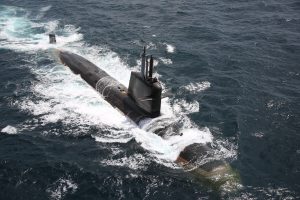In a rare show of strength, last week the Indian Navy simultaneously deployed 11 of its 16 conventional submarines. The submarines were reportedly deployed at various locations in the Indian Ocean. The Indian Navy has not undertaken such a heavy simultaneous deployment in about three decades.
While this is a milestone, there is also the reality of the shrinking Indian submarine fleet. Without timely replenishment, India could end up with a submarine fleet similar to that of Pakistan, although Pakistan is the only South Asian navy that operates a submarine with air-independent propulsion (AIP).
Reflecting on the deployment and India’s failing submarine strength, an Indian naval official who spoke to the media anonymously said that he had “not seen such a high simultaneous deployment. This was basically because we did not have that many submarines in operations, and the fleet strength was hit by several undergoing refits or repairs.”
According to the International Institute for Strategic Studies’ Military Balance 2024 report, India has 16 operational submarines, which include five Kalvari-class (French Scorpene), four Shishumar-class (German Type-209), and seven Sindhugosh-class (Russian Kilo) submarines in operation. Another Kalvari-class submarine is to be commissioned into the navy soon; this will bring the overall number to 17.
However, the real question is “operational availability,” as another naval source told an Indian media outlet. According to this official, given that the Kalvari class is brand new, “their availability ratio is much higher.” The German-origin Shishumar submarines also appear to be high on reliability and performance, making their operational availability quite good. They are likely to be around for another decade and a half.
As for the Russian Kilo-class submarines, they are considered “very good but their availability ratio is down.” Given that the Russian Kilos became operational in the 1980s, with multiple repairs and upgrades already undertaken, they are close to decommissioning. The INS Sindhudhvaj, which was in service for 35 years, was decommissioned in 2022, while a second Russian submarine was refurbished and handed over to Myanmar in 2020, and a third (a new one actually) was lost in 2013 in an accident. The German submarines have also seen their service life extended through the medium refit life certification (MRLC) process, but they may outlast their Russian counterparts in the Indian Navy.
The Indian Navy’s pitch for another six advanced submarines is facing considerable delays, to the tune of ten years. It is unlikely that the first of these will be delivered by 2030.
Meanwhile, Germany is pushing for an intergovernmental deal to supply new submarines to India. As of February, both Germany and Spain are competing for the $5 billion-plus deal with India. Thyssenkrupp Marine Systems (TKMS) of Germany and Navantia, Spain’s state-owned firm, are in the final race, having met the different criteria set out by the Indian Navy for six P-75I submarines. Navantia has partnered with an Indian firm, Larsen & Toubro, while TKMS has tied up with the Mazagon Dock Shipbuilders Limited (MDL). Under the Navantia-L&T agreement, Navantia will design the P-75I submarines, and L&T will construct the submarines. These submarines will be designed on the basis of Spain’s S-80 class, which was launched in 2021. Germany has made a proposal for a government-to-government deal to sell the six submarines to India.
Indian official sources who have spoken to the Indian media say that the next submarines that will be inducted should have a well-established AIP module that will allow the submarine to stay submerged for two weeks. Going by the latest reports, both bids have been evaluated and some preliminary assessment has been made. Reportedly, Navantia has proven its capability and has agreed to a complete technology transfer. Navantia’s AIP module is also considered to be more efficient. And given that Navantia is a state-owned entity, governmental guarantees have greater reassurance value.
While India’s underwater combat capabilities are one issue, there is also the issue with the overall numbers for the Indian Navy. India has ambitious plans to have a much larger and capable fleet by 2050, but there are several constraints, including budgetary limitations and scaling issues. Based on India’s strategic requirements and vast coastline, India aims to have a fleet of around 155-160 warships, including submarines, aircraft carriers, destroyers, frigates, and other vessels, by 2030. This is in line with India’s broader maritime strategy to augment its naval capabilities and ensure maritime security in the Indian Ocean region (IOR). However, one official source who spoke on condition of anonymity said, “The figures are dynamic. But the aim now is to have at least 175 warships — if not 200 — by 2035 for credible strategic reach, mobility and flexibility in the IOR and beyond. There will have to be a concomitant increase in the number of fighters, aircraft, helicopters and drones.”
China’s growing maritime power has pushed India to become more serious about its naval strength, but the speed of indigenous production and acquisition has not kept up with the Indian Navy’s goals. Gaining access to stealth technology, financial latitude, and the lack of serial production capabilities have all been slowing down the Indian acquisition process and contributing to the depleting size of the Indian naval fleet.































